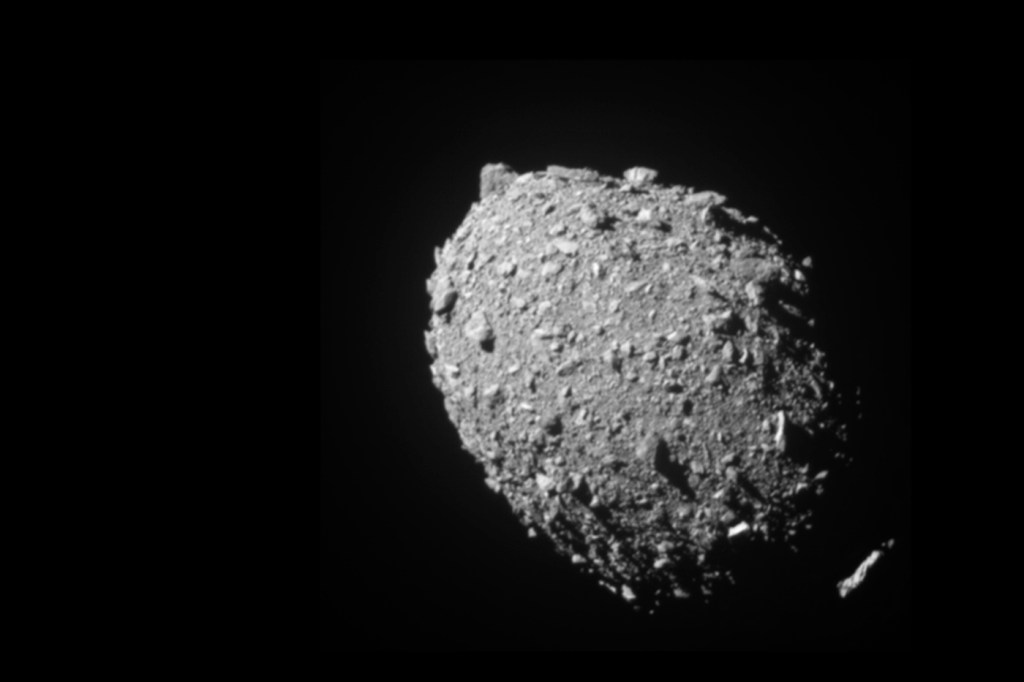NASA successfully deflected an asteroid. Here’s how they did it

“And we have impact.”
With that phrase, uttered amid the cheers of NASA scientists and engineers Monday evening, the agency’s so-called Double Asteroid Redirection Test, or DART, mission concluded. The team had achieved something humanity had never done before: successfully crash a spacecraft into an asteroid, altering the orbit of an object in space.
“For the first time, humanity has demonstrated the ability to autonomously target and alter the orbit of a celestial object,” Ralph Semmel, director of the Johns Hopkins University Applied Physics Laboratory, which managed the mission, said after the collision, the New York Times reports.
The “double asteroid,” referring to the near-Earth system of Didymos, the larger asteroid, and Dimorphos, its “moonlet,” was not a threat to Earth. But the pair of space rocks were suitable test subjects for the first-of-its-kind planetary defense mission—a proof of concept that could help human beings deflect actual cosmic threats in the future.
“That system is a member of the Apollo asteroids, not the Apollo mission, but a class of asteroids that are ‘Earth-crossing,’ as they call it,’” says Jacqueline McCleary, assistant professor of physics at Northeastern University.

At their closest approach to the Earth, Apollo asteroids are inside the Earth-Sun orbit, McCleary says. While Dimorphos, which is about 525 feet across, and its parent asteroid Didymos, which is about a half-mile long, don’t pose an imminent threat to Earth, they belong to a class of objects that are of considerable interest due to their proximity, McCleary says.
The DART mission, in effect, was to send a specially designed spacecraft to collide with the space rock at such velocity as to produce an impact equivalent to “2.6 tons of TNT,” McCleary says, or “a good-sized military bomb.”
“It’s incredibly sophisticated technologically, but in essence, you are trying to shoot a bullet out of the sky with another bullet,” McCleary says. “In this case you’ve got this satellite hurtling towards this little moonlet Dimorphos, which is like a proof of concept that one can hit an asteroid with enough momentum to cause a change in its orbit.”
“All of the momentum of [the] DART [spacecraft], all of its energy, gets transferred to this little moonlet and actually moves its orbit inwards,” McCleary says. “So it’s not pushing it out from the parent body—it’s actually pushing it in a little bit.”
“On the one hand, this is Kepler’s Third Law, which has been known for centuries,” she continued, “and first-year physics: you hit one thing with another thing, it will move. It’s bumper cars.”
Of course, with all ground-breaking space missions, there is the potential to encounter unknown unknowns. The primary unknown here, McCleary says, is the degree of the deflection, or just how much Dimorphos’s orbital period changes as a result of the impact.
“If you take as baseline, 11 hours and 55 minutes—will the new orbital period be 11 hours and 45 minutes? Will it be 11 hours and 20 minutes?” she says.
And the exact degree—the amount by which the orbital period could change—depends on a few factors, such as the DART probe’s angle of impact. Such high-speed collisions—the spacecraft crashed into Dimorphos while traveling at more than 14,000 miles per hour—can produce a “spray” of debris that could also, when all is said and done, influence Dimorphos’s post-crash orbit. Scientists also don’t know exactly what the space rock, which some scientists describe rather like a “loosely bound rubble pile,” is made of.
“It’s hard, therefore, to know how its surface will react to the collision,” McCleary says.
Elena Adams, the mission’s systems engineer, said the spacecraft made contact with Dimorphos at roughly 17 meters from its center, the New York Times reports.
The unprecedented crash quest was also an opportunity to try out a new propulsion system that uses solar panels to charge xenon ions to very high speeds. The gridded-ion thruster, or NASA’s Evolutionary Xenon Thruster-Commercial (NEXT-C), is designed for “speed and longevity,” McCleary says, and is up to three times faster than the ion drives used in previous deep space missions.
“It’s a demonstration, not just of this proof of concept, but of several really cool technologies,” she says.
For media inquiries, please contact media@northeastern.edu.






